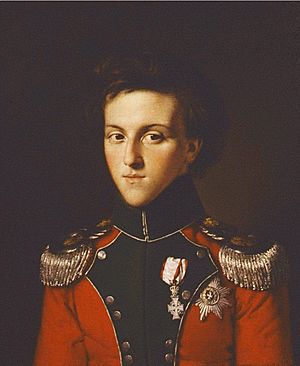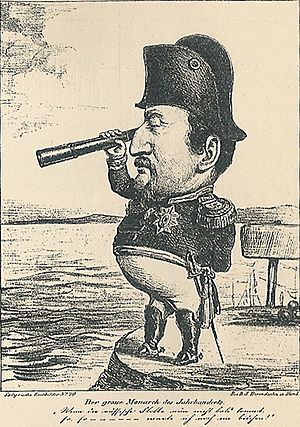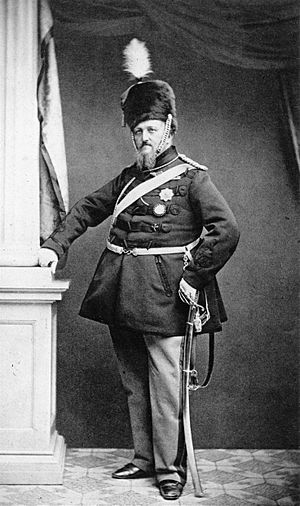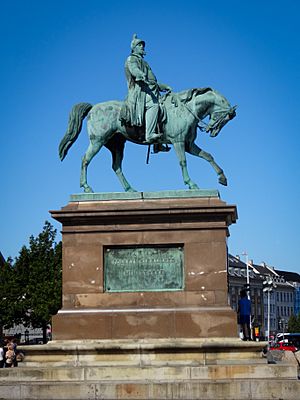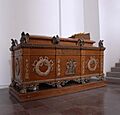Frederick VII of Denmark facts for kids
Quick facts for kids Frederick VII |
|||||
|---|---|---|---|---|---|
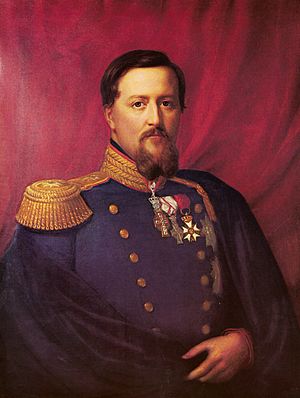
Portrait by August Schiøtt, c. 1850
|
|||||
| King of Denmark (more...) | |||||
| Reign | 20 January 1848 – 15 November 1863 | ||||
| Predecessor | Christian VIII | ||||
| Successor | Christian IX | ||||
| Prime Ministers |
See list
|
||||
| Born | 6 October 1808 Copenhagen, Denmark |
||||
| Died | 15 November 1863 (aged 55) Glücksburg, Duchy of Holstein |
||||
| Burial | Roskilde Cathedral | ||||
| Spouse |
Vilhelmine Marie of Denmark
(m. 1828; div. 1837)Caroline Mariane of Mecklenburg-Strelitz
(m. 1841; div. 1846)Louise Rasmussen
(m. 1850) |
||||
|
|||||
| House | Oldenburg | ||||
| Father | Christian VIII of Denmark | ||||
| Mother | Charlotte Frederica of Mecklenburg-Schwerin | ||||
Frederick VII (born Frederik Carl Christian on 6 October 1808, died 15 November 1863) was the King of Denmark from 1848 to 1863. He was the last Danish king from the older part of the House of Oldenburg royal family. He was also the last king of Denmark to rule with total power, known as an absolute monarch. During his time as king, he signed a new constitution. This important document created a Danish parliament and changed Denmark into a constitutional monarchy, where the king's power was limited by laws. Frederick's special saying was Folkets Kærlighed, min Styrke, which means the People's Love, my Strength in Danish.
Contents
Early Life and Family
Frederick was born at Amalienborg Palace in Copenhagen. His parents were Christian VIII of Denmark and Duchess Charlotte Frederica of Mecklenburg-Schwerin. His grandparents on his mother's side were Friedrich Franz I, Grand Duke of Mecklenburg-Schwerin, and Luise, Duchess of Saxe-Gotha. Frederick had a challenging childhood because his parents divorced when he was young.
Frederick's Marriages
Frederick VII was married three times during his life. His first two marriages did not last.
- His first marriage was in Copenhagen on 1 November 1828 to his cousin, Princess Vilhelmine Marie of Denmark. She was a daughter of King Frederick VI of Denmark. They separated in 1834 and divorced in 1837.
- On 10 June 1841, he married for the second time to Duchess Caroline Charlotte Mariane of Mecklenburg-Strelitz. This marriage also ended in divorce in 1846.
On 7 August 1850, at Frederiksborg Palace, he married Louise Rasmussen. She was a milliner (someone who makes hats) and a former ballet dancer. Frederick gave her the title Landgravine Danner. This marriage was different because Louise was not from a royal family. Even though some noble people were upset, this marriage seemed to make Frederick happy. Countess Danner helped him connect with ordinary people in different parts of Denmark, which made him even more popular.
Becoming a Constitutional Monarch
When Frederick became king in January 1848, people immediately asked for a new constitution. This meant they wanted to limit the king's power and have a say in how the country was run. The people in the regions of Schleswig and Holstein also had different ideas about their future.
The king quickly agreed to the Danish people's wishes. In March 1848, he accepted the end of absolute rule. This led to the creation of the June Constitution in 1849. This constitution was a very important step for Denmark.
During the First War of Schleswig (1848–1851) against German powers, Frederick became a symbol of national unity. People saw him as a leader for Denmark, even though he did not fight in the war himself.
Frederick's Rule and Reforms
As king, Frederick generally acted as a constitutional monarch, meaning he followed the new laws. He did not completely stop getting involved in politics, but he mostly respected the new system. For example, he helped remove a very conservative government in 1854. Later, in 1859–1860, he supported a more liberal government.
His reign saw the rise of the National Liberal Party, which was in power from 1854. This time brought many important changes and improvements for Denmark:
- The old walls around Copenhagen began to be taken down, allowing the city to grow.
- In 1857, free trade was introduced, which helped the economy.
There were ongoing disagreements with Germany about the regions of Schleswig and Holstein. Germany did not want Denmark to unite with Schleswig. These issues caused some changes to the constitution and led to frustration in Denmark. The National Liberals eventually decided to take a stronger stand against Germany. This decision led to the Second War of Schleswig in 1864, which happened shortly after Frederick's death.
The Question of Succession
Frederick VII was married three times, but he did not have any children who could legally inherit the throne. Because of this, it was important to find a new heir to the Danish throne.
In 1852, his second cousin, Prince Christian of Glücksburg (1818–1906), was chosen as the person who would become king after Frederick. Prince Christian was a good choice because he was related to the royal family and had grown up in Denmark. He was also married to Princess Louise of Hesse-Kassel, who was a close female relative of Frederick VII. Her family gave up their claims to the throne in favor of Louise and her husband.
When Frederick VII died in 1863, Christian became the new king, known as Christian IX. This marked the beginning of a new royal line for Denmark.
The issue of who would inherit the regions of Schleswig and Holstein was more complicated. These regions had different rules for succession than Denmark. After Frederick VII's death, a distant relative, Frederick, Duke of Augustenburg, claimed these regions. This disagreement about who should rule Schleswig and Holstein eventually led to the Second War of Schleswig.
Frederick VII died in Glücksburg in 1863 from an illness. He was buried in Roskilde Cathedral.
Frederick's Legacy
Frederick VII became one of the most popular Danish kings in recent history. This was partly because he gave up absolute power and allowed Denmark to become a constitutional monarchy. It was also because of his friendly personality.
Even though he had some personal challenges, he was known for being down-to-earth and genuinely kind. He enjoyed meeting ordinary people during his many travels across Denmark. He was also very interested in history and ancient artifacts. According to a later Danish archaeologist, P.V. Glob, Frederick helped many people become interested in Denmark's old treasures.
Images for kids
-
A 2 rigsdaler coin from 1863, showing the death of Frederik VII and the start of Christian IX's reign
See also
 In Spanish: Federico VII de Dinamarca para niños
In Spanish: Federico VII de Dinamarca para niños


